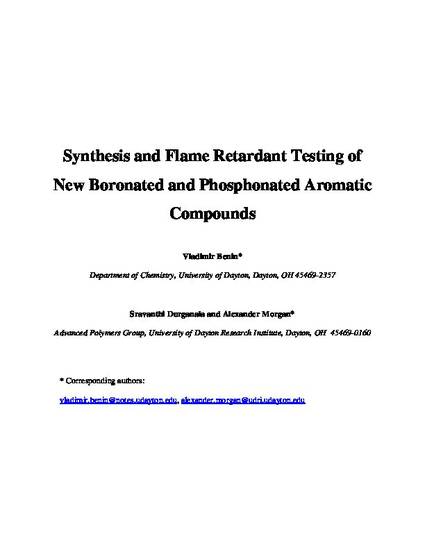
The present report describes the preparation and use of some dimethyl terephthalate derivatives in transition metal-catalyzed coupling reactions to produce new reactive flame retardants. Dimethyl iodoterephthalate and dimethyl 2,5-diiodoterephthalate were successfully employed in the preparation of phosphonic and boronic esters and acids. The latter were tested for heat release with a microcombustion calorimeter (ASTM D7309) to determine the potential for heat release reduction of these flame retardant molecules. The results showed that the addition of boronic or phosphonic acids greatly lowered the heat release, due to a condensed phase (char formation) mechanism. Adding ester groups to the boronic acids or phosphonic acids could either completely remove all flame retardant effects or make the molecule act more like a vapor phase flame retardant. Finally, the various potential flame retardants were solventblended with a thermoplastic polyurethane to assess their flammability reduction effects by microcombustion calorimetry. The results of these experiments found that the molecules that reduced heat release the most by themselves showed the greatest reduction in heat release in a polyurethane as well, with the boronic acids yielding the greatest reduction in heat release.
- Analytical Chemistry,
- Biochemical Phenomena, Metabolism, and Nutrition,
- Chemical and Pharmacologic Phenomena,
- Chemistry,
- Environmental Chemistry,
- Inorganic Chemistry,
- Materials Chemistry,
- Medical Biochemistry,
- Medicinal-Pharmaceutical Chemistry,
- Organic Chemistry,
- Other Chemistry and
- Physical Chemistry
Available at: http://works.bepress.com/vladimir_benin/7/

The document available for download after the publisher's embargo period is the authors' accepted manuscript, made available in compliance with the publisher's policy on self-archiving.
Some differences may exist between this version and the publisher's version; as such, researchers wishing to quote directly from it are advised to consult the version of record.
Permission documentation is on file.